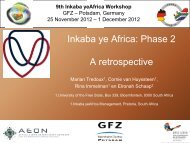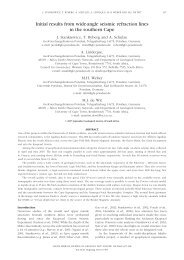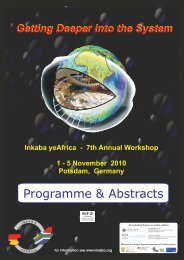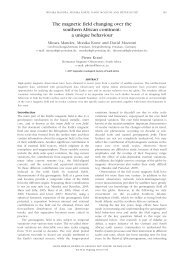South Africa - Inkaba.org
South Africa - Inkaba.org
South Africa - Inkaba.org
You also want an ePaper? Increase the reach of your titles
YUMPU automatically turns print PDFs into web optimized ePapers that Google loves.
The development and evaluation of solar desalination<br />
technology<br />
DM van Tonder 1,2 , CJS Fourie 1<br />
1. Department of Environmental, Water and Earth Sciences, Faculty of Science at Tshwane University<br />
of Technology, <strong>South</strong> <strong>Africa</strong>, dvtonder@geoscience.<strong>org</strong>.za; fouriecjs@tut.ac.za<br />
2. Council for Geoscience, Environmental Division, Pretoria, <strong>South</strong> <strong>Africa</strong><br />
ABSTRACT<br />
<strong>South</strong> <strong>Africa</strong> has limited water resources and many parts of the country have limited access to water. Almost all of<br />
its national available water resources (98%) already allocated. Predictions suggest that <strong>South</strong> <strong>Africa</strong> would have a<br />
serious water allocation problem in the very near future. In the semi-arid to arid regions of the country significant<br />
salt loading in groundwater occurs where anthropogenic influences can be excluded. Other areas are heavily<br />
impacted by mining, which results in the degradation of surface and ground water quality, specifically with respect<br />
to salinity and acidification. The energy crisis in <strong>South</strong> <strong>Africa</strong> has highlighted the need for alternative energy<br />
sources. Although solar energy has been utilsed to some extent in <strong>South</strong> <strong>Africa</strong>, the full potential for alternative<br />
uses of solar power has not been exploited. Desalination has become an accepted water treatment process around<br />
the world and is becoming a price-competitive option. Distillation involves heating a liquid until it vaporizes, and<br />
condensing the vapor and collecting it in a separate container. The most widely used solar desalination system is a<br />
simple solar still. The main disadvantage of the current simple solar still is its low yield efficiency, which rarely<br />
exceeds 50% of the input volume (10-20 l) during a day. Research on alternative designs within the <strong>South</strong> <strong>Africa</strong>n<br />
context and particularly on increasing the effectiveness of solar distillation technology is lacking. This study will<br />
focus on the development of an alternative solar desalination technology which will endeavour to improve the<br />
effectiveness of solar distillation and its application for rural water supply (to be distributed by the Science &<br />
Technology Train) by utilising solar heating panels as an alternative heat source. The project will also be applied<br />
in the mining industry in an attempt to provide an alternative, cost effective and sustainable way of improving the<br />
water quality in mining impacted areas. The proposed solar desalination technology will attempt to effectively<br />
eliminate all waterborne pathogens, salts, and heavy metals. The proposed project has the following steps: (a) the<br />
development of a laboratory set-up for testing the efficiency of the removal of salts and heavy metals from brackish<br />
drinking water and mine water, (b) the evaluation of the effectiveness and application limitations of the proposed<br />
solar distillation method and (c) the evaluation of the potential for a pilot solar desalination system.<br />
KEYWORDS: Solar, desalination, distillation, water quality, sustainable<br />
84









